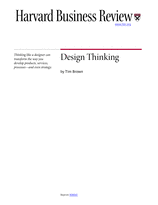Design Thinking
by Tim Brown
Thinking like a designer can
transform the way you
develop products, services,
processesand even strategy.
Reprint R0806E
Design Thinking
by Tim Brown
harvard business review june 2008 page 1
COPYRIGHT 2008 HARVARD BUSINESS SCHOOL PUBLISHING CORPORATION. ALL RIGHTS RESERVED.
Thinking like a designer can transform the way you develop products,
services, processesand even strategy.
Thomas Edison created the electric lightbulb
and then wrapped an entire industry around
it. The lightbulb is most often thought of as his
signature invention, but Edison understood
that the bulb was little more than a parlor
trick without a system of electric power gener-
ation and transmission to make it truly useful.
So he created that, too.
Thus Edison’s genius lay in his ability to con-
ceive of a fully developed marketplace, not
simply a discrete device. He was able to envi-
sion how people would want to use what he
made, and he engineered toward that insight.
He wasn’t always prescient (he originally be-
lieved the phonograph would be used mainly
as a business machine for recording and replay-
ing dictation), but he invariably gave great con-
sideration to users’ needs and preferences.
Edison’s approach was an early example of
what is now called “design thinking”a meth-
odology that imbues the full spectrum of inno-
vation activities with a human-centered design
ethos. By this I mean that innovation is pow-
ered by a thorough understanding, through di-
rect observation, of what people want and
need in their lives and what they like or dislike
about the way particular products are made,
packaged, marketed, sold, and supported.
Many people believe that Edison’s greatest
invention was the modern R&D laboratory
and methods of experimental investigation.
Edison wasn’t a narrowly specialized scientist
but a broad generalist with a shrewd business
sense. In his Menlo Park, New Jersey, labora-
tory he surrounded himself with gifted tinker-
ers, improvisers, and experimenters. Indeed,
he broke the mold of the “lone genius inven-
tor” by creating a team-based approach to in-
novation. Although Edison biographers write
of the camaraderie enjoyed by this merry
band, the process also featured endless
rounds of trial and errorthe “99% perspira-
tion” in Edison’s famous denition of genius.
His approach was intended not to validate
preconceived hypotheses but to help experi-
menters learn something new from each iter-
ative stab. Innovation is hard work; Edison
made it a profession that blended art, craft,
Design Thinking
harvard business review june 2008 page 2
science, business savvy, and an astute under-
standing of customers and markets.
Design thinking is a lineal descendant of
that tradition. Put simply, it is a discipline
that uses the designer’s sensibility and
methods to match people’s needs with what
is technologically feasible and what a viable
business strategy can convert into customer
value and market opportunity. Like Edison’s
painstaking innovation process, it often en-
tails a great deal of perspiration.
I believe that design thinking has much to
offer a business world in which most manage-
ment ideas and best practices are freely avail-
able to be copied and exploited. Leaders now
look to innovation as a principal source of dif-
ferentiation and competitive advantage; they
would do well to incorporate design thinking
into all phases of the process.
Getting Beneath the Surface
Historically, design has been treated as a
downstream step in the development process
the point where designers, who have played
no earlier role in the substantive work of inno -
vation, come along and put a beautiful wrap-
per around the idea. To be sure, this approach
has stimulated market growth in many areas
by making new products and technologies
aesthetically attractive and therefore more de-
sirable to consumers or by enhancing brand
perception through smart, evocative advertis-
ing and communication strategies. During the
latter half of the twentieth century design be-
came an increasingly valuable competitive
asset in, for example, the consumer electron-
ics, automotive, and consumer packaged
goods industries. But in most others it re-
mained a late-stage add- on.
Now, however, rather than asking designers
to make an already developed idea more at-
tractive to consumers, companies are asking
them to create ideas that better meet consum-
ers’ needs and desires. The former role is tacti-
cal, and results in limited value creation; the
latter is strategic, and leads to dramatic new
forms of value.
Moreover, as economies in the developed
world shift from industrial manufacturing to
knowledge work and service delivery, innova-
tion’s terrain is expanding. Its objectives are
no longer just physical products; they are new
sorts of processes, services, IT-powered inter-
actions, entertainments, and ways of commu-
nicating and collaboratingexactly the kinds
of human-centered activities in which design
thinkin














 분야
분야


